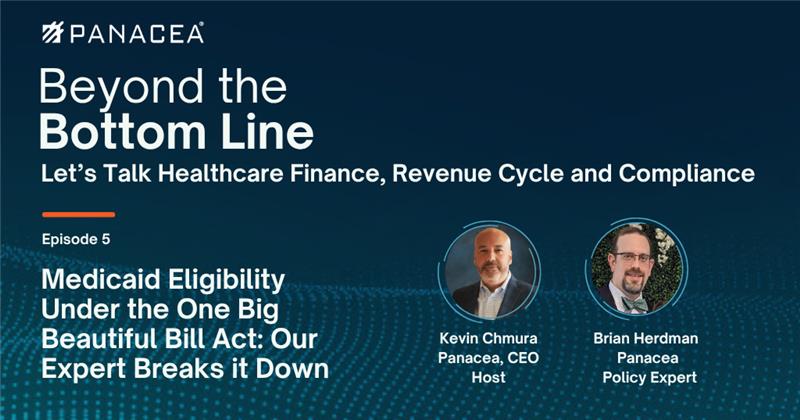Beyond the Bottom Line

Beyond the Bottom Line
Podcast Insights
Content Themes
The podcast focuses on themes such as healthcare finance, regulatory changes, and cost management, with episodes discussing Medicaid funding cuts, price transparency regulations, and coding compliance challenges in healthcare settings.

Welcome to Panacea’s podcast Beyond the Bottom Line: Let’s talk healthcare, finance, revenue cycle and compliance. Hosted by, Kevin Chmura, CEO of Panacea Healthcare Solutions. Whether you’re a healthcare executive, a financial professional, or simply curious about how these essential pieces of the healthcare puzzle fit together, you’re in the right place. Our goal is simple to give you actionable insights and expert perspectives that can help you optimize your operations and drive strategic growth.
#top .hr.hr-invisible.av-lp0dm4z0-ecbd31d22a8f649a0b55c5e684e7f0bc{
height:15px;
}
box-shadow:none;
}
.avia-image-container.av-lp0ehts2-4651558e3615e819bf1aaa2b983f5b55 .av-image-caption-overlay-center{
color:#ffffff;
}
Medicaid Eligibility Under the One Big Beautiful Bill Act: Our Expert Breaks it Down
With Host Kevin Chmura, CEO of Panacea Healthcare Solutions and Guest Brian Herdman, Director, Financial Reimbursement Services, KA Consulting Division
#top .hr.hr-invisible.av-46zq5v-ac3d0c5b9ed47d8f3785414847690b8c{
height:15px;
}
In this episode of Beyond the Bottom Line, Kevin Chmura is joined by policy expert Brian Herdman to discuss how the One Big Beautiful Bill Act is set to impact Medicaid eligibility, what this critical issue means for hospitals and healthcare providers, and how these changes can affect your bottom line.
Kevin and Brian dive into not only what changes providers can expect to see right away, but also those changes which will be coming into play in the next few years, and how to best prepare before they happen. They also explore what challenges hospitals can expect to see as a result of this bill’s passage, as well as if there are any positives for healthcare systems or providers.
Episode transcript available below.
Kevin Chmura
Hi, and welcome back to Beyond the Bottom Line, Panacea’s Podcast exploring the business and policy issues that matter most to healthcare organizations. I’m your host, Kevin Chmura, CEO of Panacea Healthcare Solutions.
In this follow-up episode, we’ll continue our conversation with Panacea’s policy expert, Brian Herdman, about Medicaid funding, a critical issue for hospitals and healthcare providers, and take a closer look at how the latest developments in Congress and the administration could impact your bottom line. We’ll also revisit some of the practical steps you should be thinking about today to strengthen your organization’s financial position now that we’ve seen how these policy issues have unfolded. So Brian, welcome back to the podcast.
Brian Herdman
Great to be here.
Kevin Chmura
Great to have you back. So, Brian, the One Big Beautiful Bill Act, the OBBBA has now been signed into law and we did a podcast on this topic in March, at which point we were really looking at the versions of the bill that were being kicked around. We were really probably going more off of what we were seeing in the press, in the media, and less what we really knew.
Now we’re getting a real look at it. You’ve had an opportunity to spend some time with the text and do your analysis. You are by far our best regulatory expert here at Panacea, so interested in in what you’re saying now, we can spend a lot of time going through the individual provisions as they relate to Medicaid and those things that will be deeply impactful.
If we went through all of them, this would be a three hour podcast and I think we lose a lot of the audience. I thought maybe what would be better for everybody, given your expertise in this area? Probably crafting it a little to our target audience, which is probably mostly hospitals and health systems, wondering if you might just spend some time talking about those provisions and those elements that you’re paying the most attention to, the things that you think will be most impactful.
And maybe we just take the conversation from there.
Brian Herdman
Sure. Sure, Kevin. So, you know, after all that back and forth and all those, you know, 4th of July deadline to get the bill passed and whatnot, there is a lot of, you know, what’s going to stay in, what’s not going to stay in between the House and Senate reconciliation process. And now that that has shook out, you know, as I’m looking at the Medicaid specific provisions, because I think that’s where the big change is going to be for our clients, on that Medicaid provisions, you know, there’s kind of two kind of two way, two sets of issues our clients are going to have to look at, you know, the things are going to affect which specific claims are going to be eligible for Medicaid and at what amount. And just generally speaking, the environment that the state, that the provider operates in the state with the state’s Medicaid program, what’s happening with FMAP, what’s happening with state directed payments and how is that going to all unfold? So as I’m looking at those two kind of main themes, you know, what’s happening like, you know, soon what’s happening soon-ish and then, you know, what’s kind of pushed out far ahead.
And when I look at the things that are coming up soon, it’s not anything that’s like, you know, hair on fire, oh, my gosh, we have to do a lot of things differently. There was that immediate elimination of some moratorium on some things that would get you streamline applications into Medicaid. That’s going away. And, you know, there is that reduction in FMAP percentage to states when they have done that expansion.
But, you know, on the margins, none of those things are going to be a dramatic change to how our clients, you know, get how many of those claims go through and how much they really get paid by the state. When you really start to see that happen is around January 2027. That’s when we’ll start to see a lot of big changes.
And looking at those kind of changes right away our of the gate, that’s when you have the introduction of co-payments for enrollees that are at 100% or more of the federal poverty limit. That’s when that six-month redetermination process with that much tighter limits on retroactive coverage and work requirements, that’s coming into play in January of 2027. So, you know, up until then, I don’t think the kind of claims that get paid by Medicaid, there’s going to be a lot of change.
But once you hit January 2027, all bets are off and you’re going to have to really have yourself organized. And then there’s those state directed payments. You know, that’s going to be much more difficult to foretell. There are a number of things that are going to affect how states are paid. There’s a couple of different dimensions that they’re tweaking the FMAP percentages on.
But generally speaking, it’s that expansion population and how various undocumented beneficiaries are treated or allowed to be covered. Once states, you know, start to deal with the change in how that money is coming in from the feds, then that’s when you might start to see states start paying providers differently, whether it’s, you know, maybe a perhaps in margin on the erosion, on a on a payment or if you’re relying on those state directed funds to make up your margin, you know, you’re really going to be limited in what you can get from it.
Kevin Chmura
Okay, that’s excellent. Maybe double click on a few of these. I think it’s difficult for you and I as we sit here to comment on individual states, because depending on where people are listening in from, it could be very, very different scenarios. You and I are both in New Jersey right now. We don’t want to make this too New Jersey centric.
A couple of things that really jumped out at me that I think that you touched on and just curious what your thoughts are. For instance, the work requirements for Medicaid, for those that are in the expansion population aged 19 to 64. That provision doesn’t start until December 31st, 2026, I believe, which is effectively January 1st, 2027.
Is that right?
Brian Herdman
That is correct. So when I was talking about like in the short term, you know, the kinds of patients that you would expect to get paid and covered under Medicaid isn’t going to change a whole lot. But once you hit January 2027, that’s where on the margins there’s going to be some very difficult cases to get through.
Kevin Chmura
Right. Likely then flowing out and up to another year later as things flow into state budgets as well. So that might not be directly budgetary impact. That’s a that’s a process issue, one that matters. The other process issue that jumped out at me as I think about our eligibility enrollment business at Panacea, is the increased eligibility redeterminations down to six months from a year.
Any thoughts on that?
Brian Herdman
Well, that’s, you know, that’s going to challenge, you know, your systems and how you’re usually interacting with patients. You know, when it’s when it’s a year in between these cycles, you are often dealing with someone who if they had an encounter that was a that was a spate of illness that got them on to Medicaid and had some follow-up care, you still might be in touch with them six months down the road, whereas twelve months down the road they might not need any care.
And so in that case, you’re going to you’re going to be much more interested in making sure that care continues and you’re going to have to be more engaged with your patients. As you look at what services those patients that are trailing off and receiving, and how you reach out to them to make sure that their coverage continues without a break.
Kevin Chmura
Yeah, that’s great. So the other thing to think about is the other side of a of an application. So at a hospital you work with a patient, you have them fill out the application, you gather up their documentation that then goes to a county office who just doubled up the amount of work that is potentially flowing through and probably not one-for-one doubling, because you’re right, if a patient doesn’t need care six months out, they may not get that redetermination.
But the good chance they’re still in an episode of care and need to do that and the depending on where you are, those county offices can be well back-logged to begin with.
Brian Herdman
And now they’re looking at the work requirement portion of it, too. So that’s another layer that they’re going to have to somehow verify or audit as they’re going through this process. So it’s not going to be easy at these county offices doing these processing.
Kevin Chmura
No, no. I always felt for the folks that work in those offices anyway, because they do very important work on typically limited resources, but about to get a lot tougher. And I’ll throw one more into the mix, and that’s the reduction, the reduction and retroactive coverage just tightened up the time frame by which applications need to be initiated down really to, I believe one month.
If I was reading it correctly from previous days.
Brian Herdman
Yeah.
Kevin Chmura
Yeah. For a lot of states and so and so an urgency to get applications in coupled with increased amount of data that needs to be interpreted and then at a higher frequency than it ever was in the past, is that good synopsis of it?
Brian Herdman
That is that is going to be a whole lot of needing to get done with more than less on both sides of the ledger.
Kevin Chmura
I tell you what, it’s a as is often the case probably with these things, the economic drivers are what everybody pays attention to. And so the realities of the of what a change in a, say, regulation or in this case a way that the program is administered. It’s not necessarily really thought all the way probably through to the end user of it.
So that is a, and from where we sit, we know from our business that’s a huge it’s going to be a huge change to the people that we work very closely with to enroll these people in Medicaid. Whether you use an outside firm like ours or you’re handling it yourself, those applications all go to a single point in whatever county your hospital sitting in and it’s that, it’s going to be a tough one.
That’s going to be a challenge. And I don’t want to challenge how much you remember about the bill. I think some of those provisions actually kick in at different times, too. So, yes, you don’t get the big bang overnight. All of it’s going to change. It chips away at you over time.
Brian Herdman
You know that chipping away, you know, is that we’re going to have a layered effect. And I think we’ll see a lot of state legislatures, at least having the discussion. You know, if they are an expansion state, is there going to be that pressure to eliminate that? Or if they have a program that covers undocumented via you know, child care program or something else, that there’s going to be other pressures on that.
So all these providers in those areas are going to have to watch and pay attention because, you know, depending how their state legislature goes, there’s a cohort that may all of a sudden need coverage and be in in their uninsured population where they had been in the past.
Kevin Chmura
Yeah, that, right. And then couple that with a reduction in the federal funding of most of the programs that were covered under the Affordable Care Act, which just will constrict the amount of money flowing through the system to cover all these folks on top of a greatly increased administrative burden. I want to challenge you, Brian, but is there any good news in this bill?
Brian Herdman
I mean, the doctors get a little bit of a bump next year. I mean, that’s, and that’s just on the Medicare side and that’s one year and that’s going to go back and back down after that. So we’ll see how this rolls out.
Kevin Chmura
Okay, great. So maybe one last question, because I think if we dive in, any of these we’ll go way too long. I believe some of these provisions, many of these will be subject to some version of rulemaking. Yeah. These are general. Right. Any thoughts on that?
Brian Herdman
You know, it kind of remains to be seen. We can look at how some of these states, like Georgia and whatnot, have done with their work requirements, what happened with them as they tried to bring things on, what barriers they ran into in verifying what they could, and then what that meant from the plans going forward. So it’s going to be a very difficult process, especially on the audit side of this.
And providers are going to have to, you know, react quickly when those audits happen and see what, how they’re pushing back on the documentation that’s been submitted, especially in those early waves. When you know, this ramps up and they have to, of course, correct and get what’s needed going forward.
Kevin Chmura
Yeah. Everybody involved, every stakeholder has something new to learn along the entire continuum. So a lot going on. So, Brian, maybe we leave it there and I will reserve the right to bring you back again, because I’m sure we will learn more over time. The initial analysis that you’ve done is amazing. I know we’re going to dive deeper, spend more time with it, talk to a number of our customers, talk to some of our state legislative folks and lobbyists and see what we can learn and bring that content out to everybody as well.
So, Brian, thank you very much for joining us.
Brian Herdman
Hey, thank you for having me. I’m happy to come back.
Kevin Chmura
And talk to you soon.
Brian Herdman
Thanks.
Kevin Chmura
I’m Kevin Chmura, and this has been Beyond the Bottom Line, by Panacea. Stay tuned for upcoming episodes featuring more expert guests. We invite you to join the conversation on LinkedIn. Please follow Panacea Healthcare Solutions and connect with me and Brian. We welcome your feedback as we work to bring you the most relevant and impactful content in the industry.
We’ll talk again soon.

Disclaimer
This podcast’s information is provided for general reference and was obtained from publicly accessible sources. The Podcast Collaborative neither produces nor verifies the content, accuracy, or suitability of this podcast. Views and opinions belong solely to the podcast creators and guests.
For a complete disclaimer, please see our Full Disclaimer on the archive page. The Podcast Collaborative bears no responsibility for the podcast’s themes, language, or overall content. Listener discretion is advised. Read our Terms of Use and Privacy Policy for more details.
